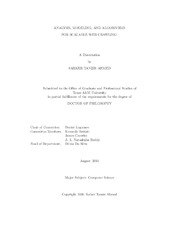| dc.description.abstract | This dissertation presents a modeling framework for the intermediate data generated
by external-memory sorting algorithms (e.g., merge sort, bucket sort, hash sort,
replacement selection) that are well-known, yet without accurate models of produced
data volume. The motivation comes from the IRLbot crawl experience in June 2007,
where a collection of scalable and high-performance external sorting methods are
used to handle such problems as URL uniqueness checking, real-time frontier ranking,
budget allocation, spam avoidance, all being monumental tasks, especially when
limited to the resources of a single-machine. We discuss this crawl experience in
detail, use novel algorithms to collect data from the crawl image, and then advance
to a broader problem – sorting arbitrarily large-scale data using limited resources
and accurately capturing the required cost (e.g., time and disk usage).
To solve these problems, we present an accurate model of uniqueness probability
the probability to encounter previous unseen data and use that to analyze the
amount of intermediate data generated the above-mentioned sorting methods. We
also demonstrate how the intermediate data volume and runtime vary based on the
input properties (e.g., frequency distribution), hardware configuration (e.g., main
memory size, CPU and disk speed) and the choice of sorting method, and that our
proposed models accurately capture such variation.
Furthermore, we propose a novel hash-based method for replacement selection
sort and its model in case of duplicate data, where existing literature is limited to
random or mostly-unique data. Note that the classic replacement selection method
has the ability to increase the length of sorted runs and reduce their number, both
directly benefiting the merge step of external sorting and . But because of a priority
queue-assisted sort operation that is inherently slow, the application of replacement
selection was limited. Our hash-based design solves this problem by making the
sort phase significantly faster compared to existing methods, making this method a
preferred choice.
The presented models also enable exact analysis of Least-Recently-Used (LRU)
and Random Replacement caches (i.e., their hit rate) that are used as part of the
algorithms presented here. These cache models are more accurate than the ones in
existing literature, since the existing ones mostly assume infinite stream of data, while
our models work accurately on finite streams (e.g., sampled web graphs, click stream)
as well. In addition, we present accurate models for various crawl characteristics of
random graphs, which can forecast a number of aspects of crawl experience based on
the graph properties (e.g., degree distribution). All these models are presented under
a unified umbrella to analyze a set of large-scale information processing algorithms
that are streamlined for high performance and scalability. | en |


